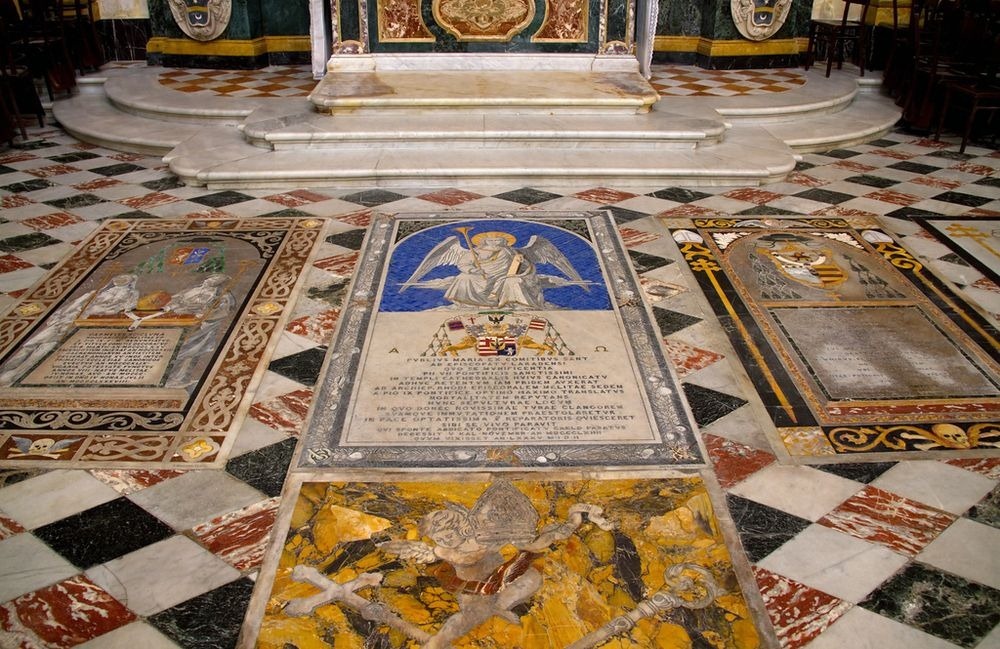Commissioned in 1572 by Grand Master Jean de la Cassière as the Conventual Church of St. John, the St. John's Co-Cathedral in Valletta, Malta, is considered to be one of the finest examples of high Baroque architecture in Europe and one of the world's great cathedrals. The cathedral's interior is extremely ornate, with carved stone walls, painted vaulted ceiling and side altars with scenes from the life of John the Baptist. The most impressive is the marble floor which is composed of nearly 400 tombstones of Knights and officers of the Order. Each tombstone is inlaid by a colored, marble slab bearing the crest, coat-of-arms and epitaph of the noble knight.

Photo credit: www.maltacultureguide.com
The Knights of the Order of St. John of Jerusalem were noblemen from the most important families of Europe, and their mission was to protect the Catholic faith against the Muslim forces. The Knights came to Malta in 1530 after they were evicted from their earlier home on Rhodes by the Turks in 1522. Using Malta as their new base, the Knights continued to fight against the Turks and especially the Barbary pirates. Unhappy to see the order resettled, Ottoman Sultan, Suleiman the Magnificent, sent an invasion force of about 40,000 men to besiege Malta. Despite having a small army of 6,000 soldiers, half of which are civilians and only 500 or so were Knights, the Turks were unable to siege the island. After defending Malta from the Ottomans, the Knights turned Malta into a fortress that befitted a military Order and built a new capital city worthy of noblemen.
The Knights who fell during the Great Siege of 1565 were originally buried in Fort St Angelo but were later re-interred inside the Cathedral of St. John’s. They were later joined by Grand Masters like Philippe Villiers de L'Isle-Adam, Claude de la Sengle, Jean Parisot de Valette, and Alof de Wignacourt. The earliest grave dates back to 1606, some 25 years after the church was opened. Bodies continued to be buried in the cathedral till the 19th century.
Today, the cathedral is one of the most popular tourist attractions in Malta, and it is listed on the National Inventory of the Cultural Property of the Maltese Islands.

Photo credit: (left) vassallohistory.wordpress.com /(right) Tony Hisgett/Flickr

Photo credit: Leon Yaakov/Flickr

Photo credit: Fr Lawrence Lew, O.P./Flickr

Photo credit: Fr Lawrence Lew, O.P./Flickr

Photo credit: Myriam Refractive/Wikimedia

Photo credit: Gwendolyn Stansbury/Flickr

Photo credit: Tony Hisgett/Wikimedia

Photo credit: Tony Hisgett/Flickr

Photo credit: Jacqueline Poggi/Flickr

Photo credit: Jacqueline Poggi/Flickr
Sources: www.knightsofmalta.com / Great Siege of Malta – Wikipedia / St. John's Co-Cathedral —Wikipedia

Photo credit: www.maltacultureguide.com
The Knights of the Order of St. John of Jerusalem were noblemen from the most important families of Europe, and their mission was to protect the Catholic faith against the Muslim forces. The Knights came to Malta in 1530 after they were evicted from their earlier home on Rhodes by the Turks in 1522. Using Malta as their new base, the Knights continued to fight against the Turks and especially the Barbary pirates. Unhappy to see the order resettled, Ottoman Sultan, Suleiman the Magnificent, sent an invasion force of about 40,000 men to besiege Malta. Despite having a small army of 6,000 soldiers, half of which are civilians and only 500 or so were Knights, the Turks were unable to siege the island. After defending Malta from the Ottomans, the Knights turned Malta into a fortress that befitted a military Order and built a new capital city worthy of noblemen.
The Knights who fell during the Great Siege of 1565 were originally buried in Fort St Angelo but were later re-interred inside the Cathedral of St. John’s. They were later joined by Grand Masters like Philippe Villiers de L'Isle-Adam, Claude de la Sengle, Jean Parisot de Valette, and Alof de Wignacourt. The earliest grave dates back to 1606, some 25 years after the church was opened. Bodies continued to be buried in the cathedral till the 19th century.
Today, the cathedral is one of the most popular tourist attractions in Malta, and it is listed on the National Inventory of the Cultural Property of the Maltese Islands.

Photo credit: (left) vassallohistory.wordpress.com /(right) Tony Hisgett/Flickr

Photo credit: Leon Yaakov/Flickr

Photo credit: Fr Lawrence Lew, O.P./Flickr

Photo credit: Fr Lawrence Lew, O.P./Flickr

Photo credit: Myriam Refractive/Wikimedia

Photo credit: Gwendolyn Stansbury/Flickr

Photo credit: Tony Hisgett/Wikimedia

Photo credit: Tony Hisgett/Flickr

Photo credit: Jacqueline Poggi/Flickr

Photo credit: Jacqueline Poggi/Flickr
Sources: www.knightsofmalta.com / Great Siege of Malta – Wikipedia / St. John's Co-Cathedral —Wikipedia
The Tombstone Covered Floor of St. John's Co-Cathedral in Valletta,
Malta
4/
5
Oleh
Chandu Numerology








